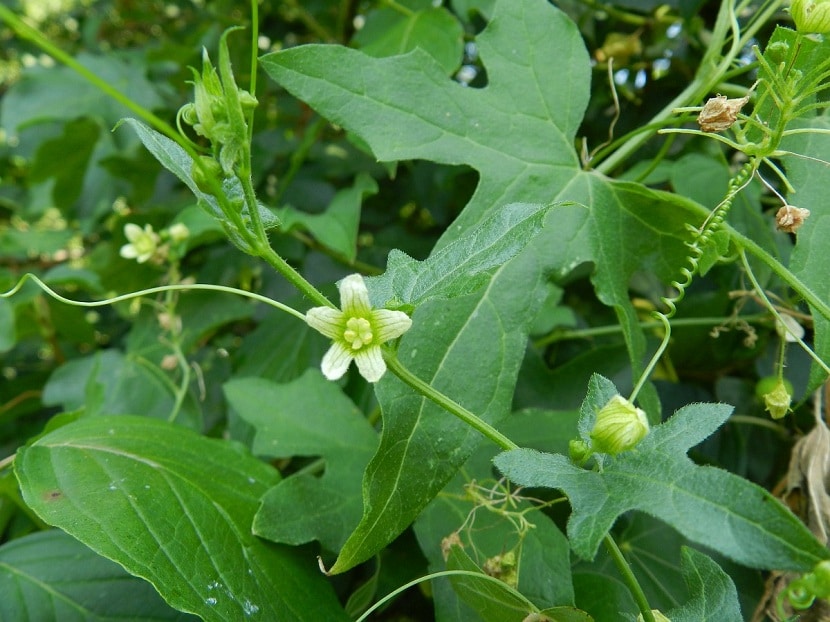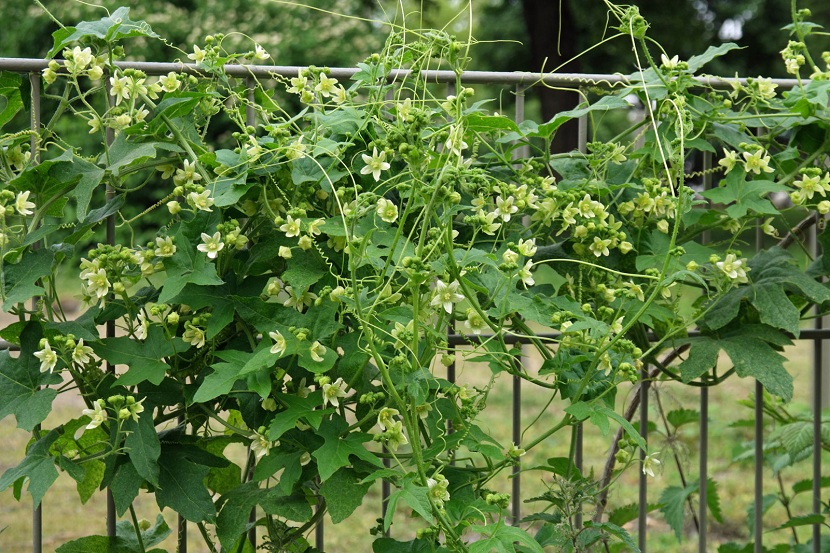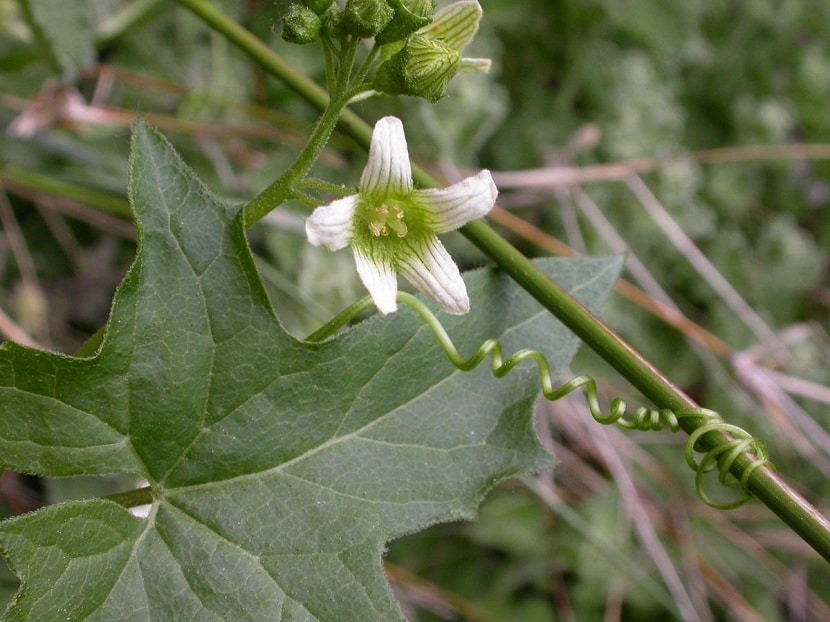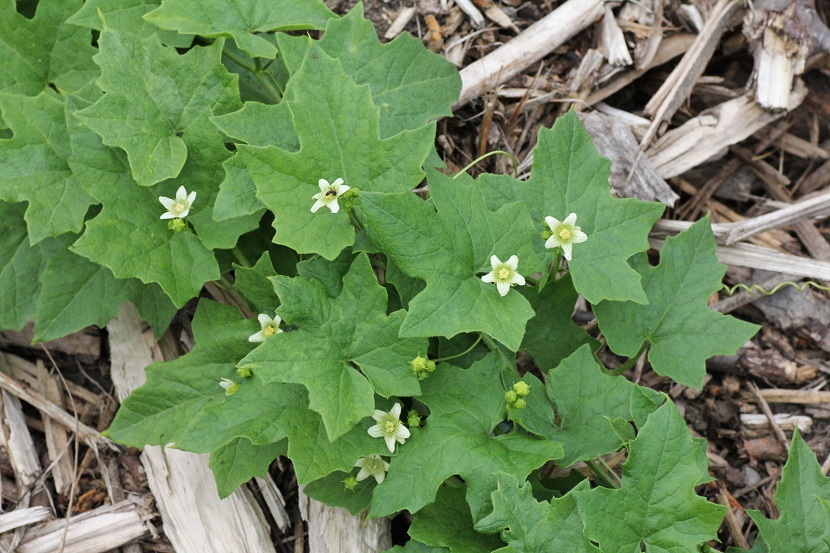
The Bryonia group of plants are characterized mainly by being a species of climbing plants that have a rapid growth. One of the species in this group is the Bryonia dioica. It is known by the common name of the devil's walnut or turnip. It is a climbing plant that comes from southern and central Europe. You have to be careful with this plant as it is poisonous.
In this article we are going to tell you all the characteristics and properties of the Bryonia dioica.
Key features

This type of plant is climbing and reach a height of 3 meters. It has pentalolulate type leaves and produces blue or white flowers. They are plants that resist frosts quite well since they originate in the part of Europe where there are areas with quite intense winters. One of the main characteristics of this plant is that it is fast growing and has evergreen leaves.
Although it is treated as a decorative climbing plant, it is poisonous. Its fruits are red fences that are also known by the name of walnut. This plant is quite old and has been known since the medicinal and magical Mediterranean area. It belongs to the cucurbitaceae family and in the Middle Ages it was known because many scammers used to take advantage of this plant to sell them as if they were mandrakes. Mandrakes used as magical amulets. Due to the similarity between both species of plants, the Bryonia dioica.
In ancient times it was believed that the root of this plant had special healing power. And it was thought that it was a fairly effective plant against the treatment of the letter. It also had a laxative effect that was already known in the Middle Ages. By just mixing a tablespoon of a preparation that was made with the root of this plant, constipation could be treated at home. Thanks to the laxative effect, some of these problems could be alleviated.
Apart from all this usefulness in folk medicine, the plant has always been quite attractive as ornamentation. This is because it has vives and red carvings that give a quite interesting touch to the areas where it is put. You should also bear in mind that, being a climbing plant, you have to be quite careful with its poison.
Flowering takes place in spring and are flower buds grouped in axillary racemes. These flowers are white or greenish-white. As the summer arrives and it approaches the autumn it is when the fruit ripens. In winter the entire aerial part of the plant moves and only the roots remain.
Toxicity of Bryonia dioica

Keep in mind that all parts of these plants are poisonous. It has a substance that can cause serious illness or even death if consumed in excess. For an adult, a consumption of about 40 berries can be completely deadly.
Just because it's toxic doesn't mean we shouldn't even touch them. You have to know how to investigate and know about certain substances that the plant has and that will help us to enjoy the environment more.
This specimen can be found in the forests, especially in the clearings, in the ruderal areas and in the sparse bushes with some humidity. You need clear areas of the woods as the most optimal location is in the sun. It is not usually used in gardening unless we are trying a green space that has other native species and with which it can mix well.
The young stalks have been consumed to be cooked as if it were a vegetable. However, you have to be careful with toxicity levels. Among the most widespread uses is medicinal. Its roots have been used for its purgative properties. Its use is quite risky so it should only be used by professionals. It is used to prepare homeopathic formulations.
Its toxicity lies in the accumulation of purgative glycosides such as brionidine or brionine and an alkaloid called brionicin. Poisoning causes abdominal pain, diarrhea and vomiting that can become complicated and cause death.
Caring for the Bryonina dioica

Although it is a toxic plant, if we are careful and know what to do, it can be a very interesting plant to add some ornamental value to our garden. We are going to analyze one by one the care that this plant needs. The first thing is the location. As we have seen before, when it grows naturally it needs to be located in clearings in the woods. This is because the main location in which we have to place this plant is in full sun. They can also tolerate semi-shade, although it is not the most ideal.
If we want to enjoy both its flowering and the color of its fruits, we must place it in full sun. As for the soil, you need soils that are deep and cool. Therefore, we must ensure that the soil has sufficient moisture continuously. To maintain this we need that watering is moderate but have a constant humidity level. Soil should not be puddled as it cannot stand puddling and would end up drowning. It is necessary that the soil has a good water drainage capacity.
As it is a plant quite resistant to the attack of pests we should not worry too much. However, as it is a plant that needs a lot of moisture continuously, it can be sporadically affected by fungi. When we see that it begins to spread by fungi we must increase the aeration.
Let's not forget that it is a toxic plant especially its berries. Its use is dangerous and only experts can treat it correctly. It has a very fast growth. So much is this growth that outside its range of origin it can become a weed. Naturally it can be found in forests especially in northern Europe. Being so poisonous plants, it has been introduced in a document of prohibited plants issued by the Junta de Andalucía.
I hope that with this information you can learn more about the Bryonina dioica.